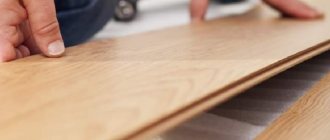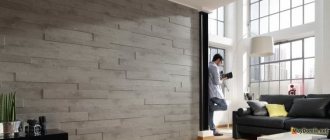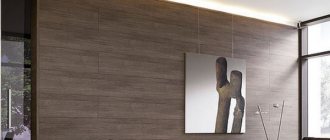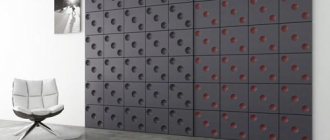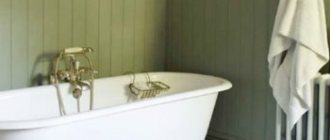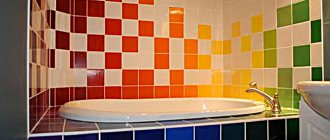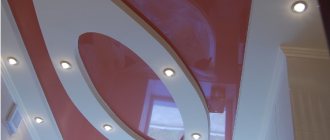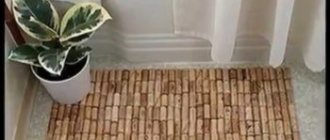The article will discuss how to attach PVC panels to the wall and to the ceiling base: possible options for fixing the material on the surface, basic step-by-step technologies, nuances of correct use of the material and creating design in rooms using it will be studied in detail. Visual examples of the design of a bathroom, kitchen, balcony and other premises will also be provided.
Fastening PVC panels to the wall can be done using adhesive, self-tapping screws or clamps
How to attach PVC panels to the wall and ceiling base: general information
Panels made of polyvinyl chloride are practical and durable. For this reason, they are widely used to decorate the surfaces of walls and ceilings in the house. Thanks to the wide variety of shapes, shades and textures, an interior based on this material can be stylish and beautiful.
PVC panels have many advantages, including durability, fire resistance, ease of installation
Advantages of the material:
- resistance to moisture;
- convenient installation system that even a beginner can handle;
- long service life;
- fire safety;
- resistance to mold, fungi and other microorganisms;
- hygiene;
- ease of care and cleaning;
- affordable price.
On the Internet you can come across photos of PVC panels for the kitchen; instead of tiles, this material looks no less beautiful, and its cost is much lower than that of tiles.
The disadvantages of polyvinyl chloride panels include a low level of impact strength. Therefore, you should carefully control the process of transporting material from the purchase site to the work area. When installing PVC wall panels with your own hands, you should also be careful not to damage them.
The walls in the kitchen are partially decorated with polyvinyl chloride panels
Before you begin installing PVC panels in the bathroom or in any other room, you should prepare the tools and materials necessary to complete the finishing work. They should always be at hand.
To renovate a room with PVC panels you will need:
- tape measure and pencil (for marking);
- hacksaws with fine teeth (for cutting material);
- building level;
- square;
- PVC panels;
- plastic profile for PVC panels or slats;
- a set of fixing elements (self-tapping screws, dowel-nails, clamps);
- hammer drill and screwdriver;
- antiseptic solution and sealant;
- ceiling plinths.
Even a beginner can handle finishing a room with polyvinyl chloride panels
At the same stage, the selection and purchase of material is carried out. There are panels on the market with different types of coating, which can be glossy or matte. In addition, manufacturers use various technologies for applying patterns and designs.
Strength characteristics depend on the thickness of the panel walls, as well as on the number of stiffeners located inside.
Features of the choice of material for wall covering with PVC panels
PVC panels from different manufacturers have different characteristics. Be sure to pay attention to the quality of the material.
To purchase a quality panel, avoid purchasing the material if:
- the stiffeners are damaged or deformed;
Decorative PVC wall panels with plant motifs
- the lines of the design on the front side of the panel are not clearly expressed, there are blurs or the edge line is blurred;
- the lamellas differ from each other in shade;
- the surface is covered with scratches;
- the dimensional parameters of the lamellas do not match (in this case, the technology for attaching PVC panels to a ceiling or wall can not only be complicated, but also impossible, since the elements will not be tightly fixed).
Characteristics of average European and Chinese panels (comparative table):
| Criterion | European lamella | Chinese lamella |
| Front side thickness, mm | 2 | 1,5 |
| Number of stiffeners, pcs. | 29 | 20 |
| External characteristics of stiffeners | smooth, no deformations | smooth, there are slight deformation changes |
| Lamel weight, kg/m? | 2 | 1,7 |
| External characteristics of the lamella | Smooth coating, stiffeners do not protrude | Smooth coating, the voids between the stiffeners are visible, there are slight deformation changes |
| Quality of raw materials | With light pressure, the lamella bends a little and returns to its original state, the presence of chalk in the composition is minimal | When lightly pressing the surface with a finger, the lamella undergoes deformation changes, which indicates a high chalk content in the composition |
How to attach a PVC panel to the ceiling and wall: preliminary calculations
Before attaching the PVC panel, it is necessary to make preliminary calculations of the material for finishing the wall.
When installing PVC wall panels, the slats can be positioned horizontally or vertically. It depends on your desire. Calculation of material for vertical installation is carried out as follows:
- Measurements of the room are taken (length of the room along the perimeter).
- The width of window and door openings is subtracted from the resulting value.
- The remainder is divided by the width of one lamella.
- The total area of the room is measured.
- The area of window and door openings is subtracted.
- The resulting value is divided by the area of one lamella.
An example of calculating panels for finishing a bathroom ceiling in two different ways
As a result, you receive the required number of panels to finish the room. Be sure to add a few extra slats in case you accidentally damage one of the elements during the installation process.
For horizontal finishing, a slightly different calculation scheme is used:
In this case, it is necessary to add at least 10% of the panels in reserve to the resulting quantity. This point is determined by the fact that when finishing a ceiling horizontally with PVC panels, as well as when working with walls, the master is faced with the need to cut the material. The result is more construction waste.
Calculation of consumables for lathing under PVC panels
If you intend to install PVC wall panels with your own hands on top of a sheathing base, you should perform additional calculations of the amount of consumables for this structure. Metal profile elements or wood slats can be used as a building material for the sheathing.
Wood slats or metal profiles can be used as materials for the construction of the sheathing.
First you need to measure the height of the walls in the room. Then divide this indicator by the step of placing the slats in the sheathing. The result of these calculations must be multiplied by the perimeter of the room. You will receive the length of the profiles or slats in linear meters.
To calculate, measure the height of the corners in the room and multiply this figure by their number. As a result, you will get the total footage of corner-type profile elements. The perimeter of door and window openings located in the room is added to this value.
Using PVC panels: how to attach plastic slats to the wall in the bathroom
Numerous photos of PVC panels in the bathroom, which can be found while looking through websites and magazines on home renovations, indicate that this type of material is quite popular among consumers.
Using plastic wall panels you can create a modern, laconic design both in the bathroom and in any other room
You can decorate a bathroom with PVC panels yourself in three different ways:
The use of an adhesive composition will be effective if you have to deal with perfectly flat and smooth surfaces.
Types of glue for PVC panels in the bathroom:
- specialized adhesive composition for polyvinyl chloride slats;
- universal composition “Moment-montazh”;
- liquid Nails.
Accessories required for installation of polyvinyl chloride panels
Installing lamellas with glue greatly simplifies and reduces the cost of renovation work in the bathroom, since the need to construct a lathing structure is completely eliminated.
The adhesive fixation method also has disadvantages. If the finish is damaged, the damaged lamella cannot be replaced with another one. Moreover, subsequent repairs will be complicated by the procedure for dismantling the old coating, which is difficult to remove from the wall.
Fixation with self-tapping screws is more convenient and reliable. To work, you will definitely need an auxiliary tool in the form of a screwdriver. Otherwise, the repair will be significantly delayed.
Manufacturers offer a wide selection of decorative plastic panels for cladding bathroom walls
The disadvantages of this method include the need to build a frame base in the form of lathing made of wood. This entails additional costs of time and money.
Clippers provide quick and reliable fixation of lamellas on the wall surface. In this case, the lathing structure must be metal.
Finishing a bathroom with PVC panels: interesting ideas, photos
Plastic finishing opens up wide possibilities for bathroom design - photos of PVC panels in the design of this room look stylish and impressive. A variety of colors and external characteristics of the material allows you to arrange the room in different styles.
A stylish bathroom in a private house is decorated with plastic panels
Eco-friendly interiors are very popular today. Of course, plastic does not belong to the category of environmentally friendly and natural materials, but in the photo of the bathroom, PVC panels with a wood texture create an excellent imitation of the ethno style. The installation of PVC panels in the bathroom on the walls is ideally combined with the ceiling decoration made using slats.
In the photos of bathrooms, PVC panels imitating tiles look so natural that they are practically indistinguishable from real tiles. In this case, you achieve significant savings in terms of material purchase costs, since plastic slats will cost much less than ceramic tiles. When renovating a bathroom with pvc panels to match the tiles, you have the opportunity to decorate the room in a neoclassical style, adding friezes, columns, borders, or make a classic finish.
When choosing a material for finishing a bathroom or toilet, you should prefer light colors - such panels look especially advantageous in these rooms
In the photo of finishing toilets with PVC panels, the light color scheme looks very advantageous. Thanks to this, you can add additional volume to a small bathroom. Modern options for decorating bathrooms include the use of products with photo printing or installation of mosaics.
How to glue PVC panels for a bathroom: recommendations
To decorate bathrooms, it is recommended to use plastic slats with a faintly textured surface. The fact is that volumetric textures can become an excellent basis for the formation of mold and fungal spores. If you buy material with large relief depressions on the surface, it will be difficult to maintain the finish later.
There are also advantages to the way PVC panels are attached to the walls in the bathroom:
- saving money - average prices for panels with standard dimensional parameters are in the range of 200-300 rubles / piece. The range of market value of the material covers prices from 100 to 500 rubles/piece. This indicator depends on the quality of the products and design;
PVC panels are easily attached to walls using adhesives
- hygiene and safety – the surface of the lamellas does not absorb unpleasant odors and can be easily cleaned with a sponge and soap solution;
- high level of resistance to moisture. For this reason, the material is suitable for rooms with high humidity levels. This property allows you to finish the loggia with PVC panels, as well as the balcony, corridor and even the kitchen;
- simplicity of the installation system - for this it is enough to have the skills to use a construction stapler and a screwdriver;
- practicality - in the photo of finishing bathrooms with PVC panels, communication systems are not visible. The material is used for lining communication ducts, where all pipes, valves and other elements are placed.
Plastic panels are a practical and budget-friendly option for cladding bathroom walls
How to glue PVC panels to walls without using lathing
Before gluing the decorative PVC panel to the wall surface, it is necessary to prepare the base. This technology requires thorough cleaning of the walls and their subsequent leveling. Errors in choosing glue are also unacceptable.
Surface preparation involves:
- complete removal of old coating;
- eliminating cracks;
- surface leveling.
The allowed size differences are within 5 mm. If the pits and bumps are deeper, over time the plastic will peel off or become deformed. There may be grease, dust, and dirt on the surface of the walls. These particles interfere with the normal adhesion of the glue. Therefore, it is advisable to wash off the whitewash from the surface of the walls, clean the grease using an effective detergent and apply a primer.
List of universal adhesive compositions:
- Emfikol 34012A;
- Kleiberite 636;
- Moment Crystal.
When installing PVC panels, you can use non-expanding polyurethane foam-based sealant or liquid nails
These compounds can be used to install PVC panels with your own hands, but experts recommend using specialized glue for plastic.
Signs of a quality composition:
- transparency after drying and formation of a film layer;
- resistance to sudden temperature changes, moisture and frost (for this reason, photos of balconies decorated with PVC panels are so often found on the Internet);
- fast setting;
- reliable and long-lasting fixation.
You can use a non-expanding polyurethane foam sealant or liquid nails. These materials are plastic and firmly fix the panels to the wall.
Plastic slats for ceramic tiles on the walls of a combined bathroom have an attractive appearance
Decorative PVC mosaic panels: how to glue, video instructions
To learn how to glue a PVC mosaic sheet panel, use the step-by-step instructions, which also apply to regular slats.
Step-by-step procedure:
If you use liquid nails in your work, the panel will need to be lightly tapped and then torn off the surface again. For better adhesion, the glue requires airing for 5-7 minutes. Then you need to fasten the lamella back into place.
Polyvinyl chloride panels are easy to maintain and do not lose their visual appeal for a long time
The frameless method does not require the formation of external and internal corners for PVC panels. Such a procedure would be inappropriate in this case. Conventional cladding using plastic corners that do not have grooves for mounting lamellas will suffice. You can use transparent silicone to secure the corners. The size of such elements varies from 2 cm to 5 cm.
For a more detailed study of the procedure for installing PVC wall panels with your own hands, use the video material posted below.
Lastly, floor and ceiling plinths for PVC panels are fixed. Use self-tapping screws for this. The joint areas between the lamellas must be filled with silicone sealant or polyurethane foam.
How to fix the last panel on the ceiling
The installation of the latest panel is different from the previous ones.
Often the last panel is installed using liquid nails
To attach it you need:
- It is necessary to cut it to the size corresponding to the remaining open space. When cutting, the integrity of the panel is compromised, thus it will not have a lock.
- Liquid nails are used to secure the last panel.
- The final element of finishing the plastic ceiling is the installation of a ceiling plinth, which will hide all the shortcomings in the installation of the panels.
Photos of kitchen aprons made of PVC panels and spacer installation technology
Most often, expanded clay or tiles are used to decorate kitchens. However, installing these materials requires special knowledge and skills, which is why you can increasingly see photos of kitchen decoration with PVC panels. Thanks to the special design of the lamellas, the wall assembly in the apron area is carried out with minimal gaps.
The technology for fastening lamellas into spacers does not involve the use of fasteners, adhesives or lathing structures. This method is used exclusively in small kitchens, where the work area can be covered with one single sheet panel.
Using PVC lamellas you can quickly and easily create a beautiful and functional apron for the kitchen wall
The apron in the kitchen is decorated using plastic panels stylized as tiles
Installation technique for plastic panels
The installation of panels is based on the “tenon and groove” principle, but initially it is necessary to install a starting profile into which they will be mounted. Fastening to a metal frame is carried out with self-tapping screws, the same can be done with a wooden one, or you can use staples. In the case of a plastic frame, the clamps will be clamps, and if there is no frame, then the panels are simply glued directly to the ceiling.
The first element of the future ceiling covering is inserted with a tenon inside the starting profile and fixed on the reverse side with a self-tapping screw, bracket or clamp. The installation scheme for the remaining panels is the same: the tenon of the already installed one is inserted into the groove of the next one with mandatory fixation. But problems may arise with the latter, although there is a solution to this issue:
- the distance from the edge of the profile to the penultimate panel is measured;
- 5-7 centimeters are discarded from this distance and the last panel is cut off;
- it is inserted into the profile from the cut side until it stops;
- the tenon of this panel is inserted into the groove of the previous one.
One more nuance regarding wiring. If it is installed under plastic, then its functionality must be checked before installing the plastic, otherwise, in case of any problems, you will have to disassemble the entire structure.
Instructions for installing PVC panels on walls over a lathing frame
Before covering the wall with PVC panels, the surface should be cleaned. There is no need for serious leveling, but if you plan to finish a bathroom, kitchen or other wet room, it is recommended to waterproof the walls and coat them with an antiseptic.
To form the lathing structure, wood blocks measuring 2x2 cm can be used. They are much cheaper than metal elements. However, it is not recommended to use wooden sheathing for rooms with high humidity levels. Before using wood, it must be thoroughly dried so that the moisture content of the material reaches the permissible norm - 12-15%. Don't forget to pre-treat the bars with an antiseptic.
To equip a metal frame, you will need a profile element UD (contour part) and CD (guides).
Installation diagram of panels and additional structural elements
Regardless of whether you make ceilings from PVC panels with your own hands or sheathe walls, the construction of a lathing structure should begin with markings. If you are working with walls, you first need to determine the lower level, taking into account the further installation of the baseboard. As a guide, you need to take the most protruding point of the wall. It is she who will determine the indentation of the sheathing.
After this, the line of the upper level (with a reference to the ceiling) and the side levels is determined. It is recommended to use a building level to control the upper and lower zones, and a plumb line for side elements.
How to attach a PVC wall panel: working with frame and cladding
The sheathing elements are fixed using direct hangers. The screws are spaced in increments of 20-25 cm (wooden frame) or 15-25 cm (metal frame). The installation of bars or metal profiles is carried out first along the edge, then inside the structure. This will ensure reliable fixation of the trim around the edges.
Various ways to install PVC panels
When installing internal profiles, it is worth considering the type of panel installation you have chosen - horizontal or vertical. The slats will subsequently have to be attached perpendicular to the guides fixed with screws.
Scheme for installing panels on the sheathing:
For a more detailed look at installing PVC wall panels with your own hands, use the video - an overview of this procedure.
Calculation of material requirements
The main material for finishing is PVC panels.
They must be purchased in optimal quantities. If suddenly there are not enough of them, then the purchased product may differ in shade, which will be visually noticeable. Excessive inventory causes unnecessary expenses. In addition to the main material for installation, you will need a metal profile for a frame of several types and a ceiling plinth as a finishing touch.
Calculation of the need for PVC panels is carried out based on the area of the ceiling and one panel. The most common elements are 4 m long and 2 cm wide .
Their area is 1 m². If you divide the area of the room by the area of the panel, you will get the required number. Next, you should take into account the cutting margin and waste. It amounts to 12-15%.
To install the frame, it is necessary to calculate different types of metal profiles First of all, a starting profile (UD) is installed around the perimeter of the ceiling. Its total length corresponds to the perimeter of the room.
We recommend: DIY ceiling repair options. What materials can be used?
A sheathing is made of guide profiles (CD) on the ceiling surface. They are mounted in increments (h) of 50-60 cm. In other words, N UD profiles will be required, with N = (B/h), where B is the width of the ceiling, each with a length equal to the length of the ceiling. The total need for guide profiles is NxL, where L is the length of the ceiling.
Another necessary consumable is ceiling plinth . It is fixed along the entire perimeter of the ceiling and is designed to mask the gap between the wall and the panels (starting profile). Its need is equal to the perimeter of the room. Taking into account the need for cutting and neat joints at the corners, a margin of about 5-6 percent is taken.
Formation of suspended ceilings from PVC panels: photos of structures and technology
The moisture-resistant properties of polyvinyl chloride panels are also useful for arranging suspended ceilings.
This material is used for arranging ceilings in various rooms:
- kitchen;
- toilet;
- shower, sauna or bath;
The process of arranging a ceiling made of plastic panels in a bathroom
- hallway;
- balcony or loggia.
In most cases, in the photo of ceilings made of PVC panels in the kitchen, you can see a material that imitates 10 cm wide lining. This finish allows you to easily install spotlights in a suspended ceiling structure.
Other design options for lamellas can be used for decoration:
- imitating wood or natural marble stone;
- matte or glossy;
- plain or covered with ornaments;
- decorated with printing or thermal film.
Before making suspended ceilings from PVC panels, it is necessary to calculate the materials. The calculation scheme in this case is very simple, since there are no window or door openings on the ceilings. Material reserve – 15% of the required quantity.
The ceiling and walls of the kitchen-living room are lined with plastic eurolining

